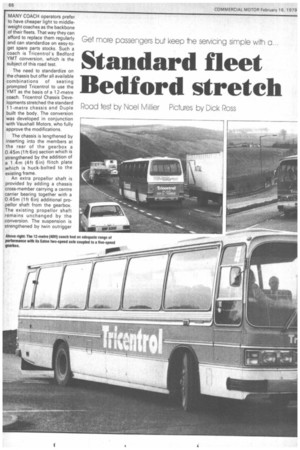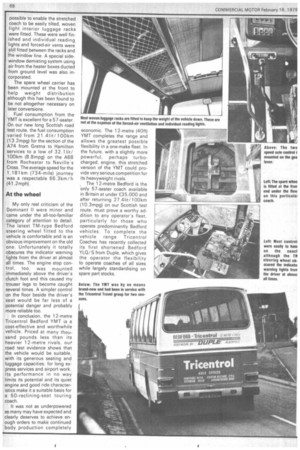Get more passengers but keep e servicing simple with a
Page 68

Page 69

Page 70

If you've noticed an error in this article please click here to report it so we can fix it.
Standard fleet Bedford stretch
MANY COACH operators prefer to have cheaper light to middleweight coaches as the backbone of their fleets. That way they can afford to replace them regularly and can standardize on easy-toget spare parts stocks. Such a coach is Tricentrol's Bedford YMT conversion, which is the subject of this road test.
The need to standardize on the chassis but offer all available combinations of seating prompted Tricentrol to use the YMT as the basis of a 12-metre coach. Tricentrol Chassis Developments stretched the standard 11-metre chassis and Duple built the body. The conversion was developed in conjunction with Vauxhall Motors, who fully approve the modifications.
The chassis is lengthened by inserting into the members at the rear of the gearbox a 0.45m (1 ft 6in) section which is strengthened by the addition of a 1.4m (4ft 6in) flitch plate which is huck-bolted to the existing frame.
An extra propellor shaft is provided by adding a chassis cross-member carrying a centre carrier bearing together with a 0.45m (lft 6in) additional propellor shaft from the gearbox. The existing propellor shaft remains unchanged by the conversion. The suspension is strengthened by twin outrigger aeon rubbers mounted at the rear and single centrallymounted aeon rubbers at the front.
I recently had a chance to take the first 12-metre (40ft) Bedford YMT, which has now been in service for many mOnths and has covered almost 96,540km (60,000 miles), over our new CM Scottish road test route.
Apart from the chassis modifications outlined above, the 12-metre YMT was fitted with an Eaton two-speed axle and 10.00 by 20in tyres. Body modifications necessary to assist initial tilt-testing requirements included the fitting of side-window demisters using hot air from the vehicle heating system and directing air to the windows from below rather than above.
The coach, which was fully laden with test weights, was fitted with 57 standard Duple seats. An extra-deep boot and side-lockers required to accommodate the luggage for 57 passengers. are also fitted. Woven-type luggage racks are also fitted, although not at the expense of forced air ventilation and reading lights which are included in the body specification.
I was pleasantly surprised by the general performance. Ride and handling were directly comparable with the standard YMT. By specifying the Eaton two-speed axle, Tricentrol Coaches have given this machine a wide performance range Using the low ratio. I found the gear ratios well spaced to cope with everyday town driving and most of the hillier sections of road.
In high-ratio top, the coach was able to cruise comfortably at 110km/ h..,(70mph) on all but the uphill stretches of motorway. I found generally that keeping the back axle in high ratio provided a useful range for motorway and dual carriageway driving, and low for all other occasions.
The change control for the two-speed axle was by a control button fitted to the gear lever, I found that changing the axle from low ratio to high ratio was easy when the engine revs were completely dropped and the clutch depressed.
Changing from high to low could prove a problem, as the engine revs need to be kept up when the clutch is depressed. The clutch has to remain depressed long enough to allow the axle to change to avoid a jerky and noisy axle change, which could well prove disconcerting for the passengers.
The ride of this converted YMT was very good. Fitting the vehicle with larger 10.00 x 20in tyres seems to remove an amount of road noise and improve handling.
Positive feel
The power-assisted steering fitted to the coach was quiet and positive. It was, however, heavier than I expected and tended to be less effective at low engine speeds. The lock made the 12-metre (40ft) vehicle very manoeuvrable for its size. The coach was fitted with Bedford's TM range's steering wheel, which looks attractive and is comfortable for the driver.
Braking tests carried out at the MIRA test track at Nuneaton in extremely wet and slippery conditions showed that the fully-laden coach could be stopped in an emergency in a straight line, allowing the driver to remain very much in control.
Hill tests carried out at MIRA also showed that the coach was easily capable of stopping and starting on a 1-in-4 test hill. The park brake also held easily. MIRA's arduous ride and handling circuit brought to light no unusual handling characteristics. In fact the coach coped extremely well with adverse cambers, pot-holes and level crossings.
Unusually for a CM road test vehicle, this coach had been in operator service for two seasons and was by no means brand new. However it showed no signs of wear, and no rattles, draughts or cracks in the body were apparent. The finish of the Duple Dominant II body was very good.
To keep the roof as light as possible to enable the stretched coach to be easily tilted, woven light interior luggage racks were fitted. These were well finished and individual reading lights and forced-air vents were still fitted between the racks and the window line. A special sidewindow demisting system using air from the heater boxes ducted from ground level was also incorporated.
The spare wheel carrier has been mounted at the front to help weight distribution although this has been found to be not altogether necessary on later conversions.
Fuel consumption from the YMT is excellent for a 57-seater. On our new long Scottish road test route, the fuel consumption varied from 21 .41it/ 100km (13.2mpg) for the section of the A74 from Gretna to Hamilton services to a low of 32.1 lit/ 100km (8.8mpg) on the A68 from Rochester to Neville's Cross. The average speed for the 1,181km (734-mile) journey was a respectable 66.3km / h (41.2mph).
At the wheel
My only real criticism of the Dominant II were minor and came under the all-too-familiar category of attention to detail. The latest TM-type Bedford steering wheel fitted to the vehicle is comfortable and is an obvious improvement on the old one. Unfortunately it totally obscures the indicator warning lights from the driver at almost all times. The engine stop control, too, was mounted immediately above the driver's clutch foot and this caused my trouser legs to become caught several times. A simpler control on the floor beside the driver's seat would be far less of a potential danger and probably more reliable too.
In conclusion, the 12-metre Tricentrol Bedford YMT is a cost-effective and worthwhile vehicle. Priced at many thousand pounds less than its heavier 12-metre rivals, our road test evidence shows that the vehicle would be suitable, with its generous seating and luggage capacities, for long express services and airport work. Its performance in no way limits its potential and its quiet engine and good ride characteristics make it a suitable basis for a 50-reclining-seat touring coach.
It was not as underpowered as many may have expected and clearly deserves to achieve enough orders to make continued body production completely economic. The 12-metre (40ft) YMT completes the range and allows the greatest possible flexibility in a one-make fleet. In the future, with a slightly more powerful, perhaps turbocharged, engine, this stretched version of the YMT could provide very serious competition for its heavyweight rivals.
The 12-metre Bedford is the only 57-seater coach available in Britain at under £35.000 and after returning 27.41it/100km (10.3mpg) on our Scottish test route, must prove a worthy addition to any operator's fleet, particularly for those who operate predominantly Bedford vehicles. To complete the vehicle range Tricentrol Coaches has recently collected its first shortened Bedford YLQ/S from Duple, which gives the operator the flexibility to operate coaches of all sizes while largely standardising on spare part stocks.




















































































































